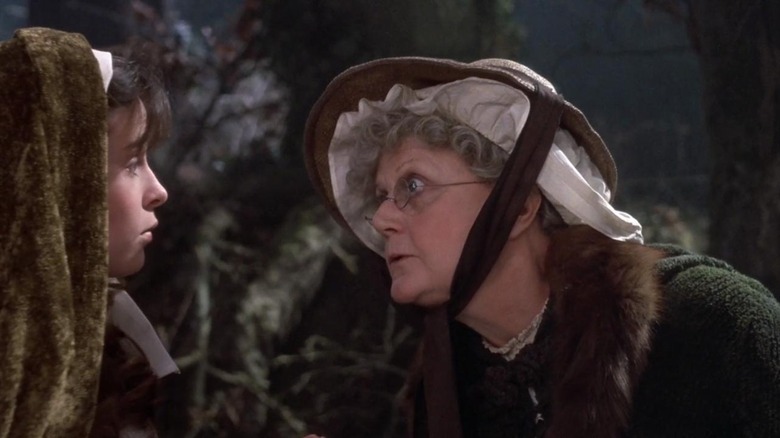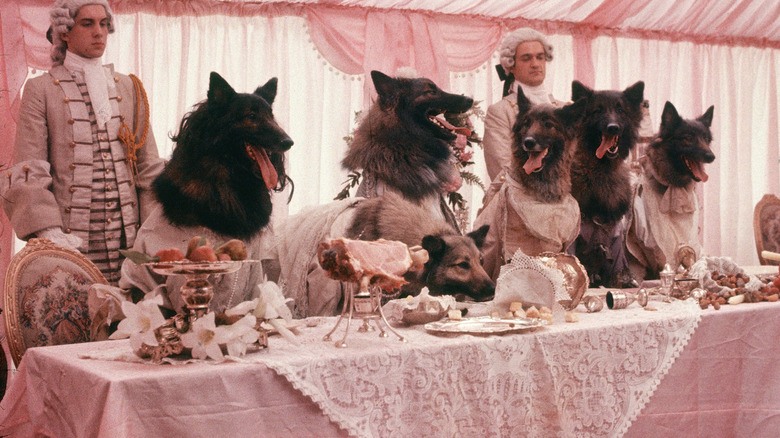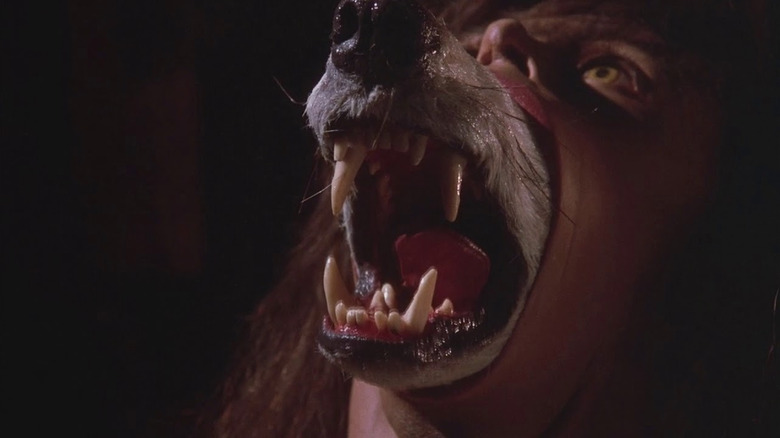Angela Lansbury's Scary '80s Fantasy Movie Is A Must-Watch On Prime Video
Neil Jordan's 1984 film "The Company of Wolves" is a marvelous re-imagining of the Little Red Riding Hood fable, presented as a horror anthology picture. "Wolves" begins in the modern day and follows a young woman named Rosaleen (Sarah Patterson) whose sister was recently killed by wolves. She goes to stay with her Granny (the late, great Angela Lansbury), who lives deep in the forest. Time is a little backward in the woods, though, and Granny knits a red hood for Rosaleen, telling her to beware of any mountebanks, especially if they have a unibrow, itself a sign of lycanthropy. The Big Bad Wolf in the Little Red Riding Hood story is, in this version of the tale, a werewolf.
That's fun enough, but "The Company of Wolves," also incorporates multiple side-stories to explore the nature of storytelling and the function of folk tales. Two of the shorts in "The Company of Wolves" are tales told to Rosaleen by Granny. The first is the story of a young bride who unwittingly weds a werewolf groom, only to have him run into the woods as an animal. The second is about a young man who sells his soul to the Devil in exchange for being made into a werewolf. People who know about werewolf lore and mythology will be able to spot that a lot of these legends are accurate to ancient stories. The unibrow thing, for instance, can be found in older books, while some legends dictate that someone has to actively consort with Satan to become a werewolf. It's clear that Jordan did his research and wanted to make a film that fell squarely between modern horror flick and ancient folk tale.
It's one of the better werewolf movies out there, and you can watch it on Prime Video.
The Company of Wolves is one of the better werewolf movies
Jordan also blends the ancient and the modern in "The Company of Wolves." One of the folk tales appears to take place in the late 18th century, yet it still features a Rolls-Royce. After Granny shares her stories, Rosaleen seems inspired, and she tells a werewolf tale to her mom (Tusse Silberg). In Rosaleen's story, an old witch confronts the decadence of the aristocracy and puts a curse on all the wealthy hedonists at a fancy dinner party. They all turn into wolves while in the middle of their meal, providing a surreal class commentary worthy of Luis Buñuel. The fourth and final story in the film is told by Rosaleen to a huntsman who, in this version of things, is also a werewolf. Her tale is about an innocent young woman who also happens to be a werewolf. She is not a monster, but an innocent, fairy-like creature who simply has no place in the human world. The werewolf is now sympathetic.
"The Company of Wolves" is also utterly gorgeous. Bryan Loftus was the cinematographer, and he gives the film Jordan's preferred foggy, rich visuals. Meanwhile, the movie's production design was handled by Anton Furst and Nigel Phelps, who would go on to create much of the look of Tim Burton's "Batman" five years later. Yes, one will notice that the wolves in Jordan's film are not actual wolves, but friendly-looking Belgian Shepherds. The movie isn't any weaker for it, though, and it's better to have trained animals than unconvincing rubber monsters. Jordan didn't have much of a budget to draw from (the film cost about £2 million), but he made it work, allowing his picture to emerge as an impressive, lush, and very adult horror movie.
The Company of Wolves also has a great transformation sequnce
Lansbury plays Granny, as mentioned, but the late (and also great) David Warner co-stars as Rosaleen's father. And while he isn't credited, Terrence Stamp plays Satan, with Jim Carter (from "Downton Abbey") making a cameo as well.
Many folks might judge a werewolf movie based on the strength of its human-to-wolf transformation sequence(s). Fortunately, despite having a shoestring budget, "The Company of Wolves" comes up with a pretty innovative visual, enough so that it even appears on the film's poster. As can be seen above, one of the movie's lycanthropes transforms when a fully-formed wolf snout emerges from his open mouth. It's a weird image and one that's unique to this film. Any kids who caught that scene on TV by accident (as I did) will have it forever seared into their brains.
Critics responded very positively to "The Company of Wolves," noting that it finally made the sexual and Freudian subtexts of "Little Red Riding Hood" into actual text. It came out well before deconstructing fairy tales in mainstream movies was de rigueur, so it felt heady and vital, like something new was being uncovered. 17 years later, Hollywood began making films that pretty much declared fairy tales were over-the-hill (with "Shrek" being the main example), but movies like "The Company of Wolves" came out at a time where literary deconstruction was still intellectually fashionable. It explored the sexuality bubbling underneath all those werewolf myths and brought it to the surface.
Again, "The Company of Wolves" is available on Prime Video, and it would make a great film to help you prepare for Halloween. It's well-liked by deep-cut 1980s horror aficionados, but it may still be unfamiliar to younger monster movie fans. It's a great horror movie for grown-ups.


